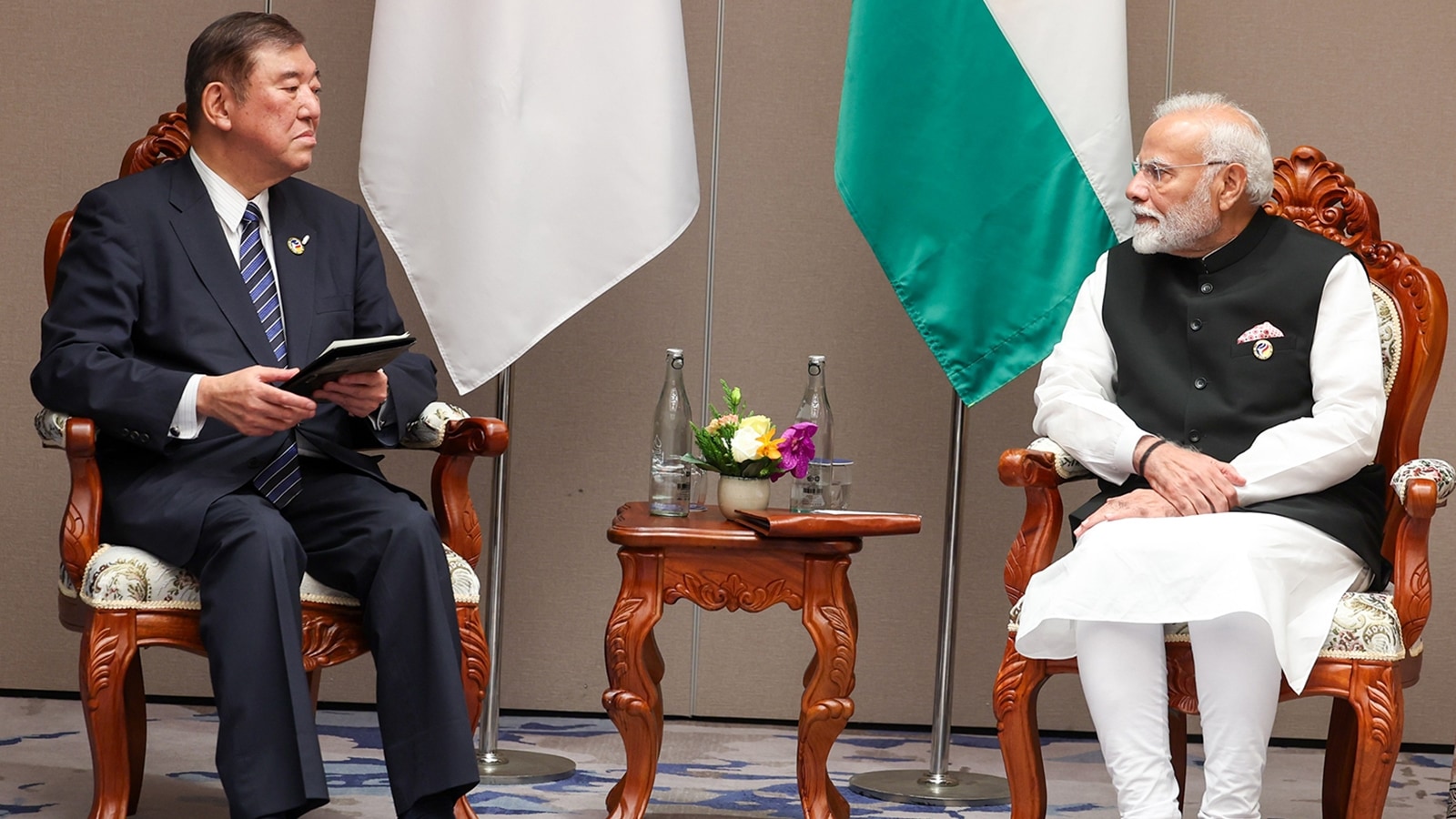Prime Minister Narendra Modi left for Japan on Thursday night (August 28) for the 15th India-Japan Annual Summit with his Japanese counterpart Shigeru Ishiba.

Modi last travelled to Japan for the Annual Summit in 2018; he has since visited the country for multilateral engagements such as the G20 summit in Osaka in 2019, and the G7 summit in Hiroshima in 2023. From Japan, the Prime Minister will travel to China for the Heads of State Council meeting of the Shanghai Cooperation Organisation (SCO) in Tianjin.
Old ties, shared vision
Japan and Russia are India’s two oldest Annual Summit-level mechanisms. India-Japan bilateral relations were elevated to Global Partnership in 2000, Strategic and Global Partnership in 2006, and Special Strategic and Global Partnership in 2014.
The Annual Summits between former Prime Minister Shinzo Abe and PM Modi gave a strategic edge to the ties. Ahead of the PM’s visit, Foreign Secretary Vikram Misri said India and Japan “share values, trust, and strategic outlook”.
The partnership between India and Japan, two of Asia’s leading democracies and among the world’s top five economies, is rooted in civilizational ties that have been reinforced by convergence in their regional and global outlooks.
 Ishiba (left) with Modi at Vientiane, Laos, last October. (Image source: X/@narendramodi)
Ishiba (left) with Modi at Vientiane, Laos, last October. (Image source: X/@narendramodi)
India’s Act East Policy and Indo-Pacific Oceans Initiative (IPOI) align closely with Japan’s Free and Open Indo-Pacific (FOIP) policy. Japan leads IPOI’s connectivity pillar, and is India’s largest Overseas Development Assistance (ODA) donor.
Story continues below this ad
Cooperation between the countries extends to plurilateral platforms such as the Quad, International Solar Alliance (ISA), Coalition for Disaster Resilient Infrastructure (CDRI), and Supply Chain Resilience Initiative (SCRI).
A joint statement and a vision statement will be issued during the PM’s visit. Sources said the two sides will exchange notes on the current global scenario. They are expected to share their strategic outlook in the wake of the tariffs imposed by the Donald Trump administration, and in the context of uncertainties about US security commitments in the Indo-Pacific.
Realms of cooperation
Defence and Security
Key agreements on defence and security include the Joint Declaration on Security Cooperation (2008), Defence Cooperation and Exchanges MoU (2014), Information Protection Agreement (2015), Reciprocal Provision of Supplies and Services Agreement (2020), and co-development of the UNICORN naval mast (2024).
EXERCISES: Malabar (with the US and Australia), Milan (multilateral naval), JIMEX (bilateral maritime), Dharma Guardian (Army), and Coast Guard cooperation are held regularly. 2024-25 saw the participation of service chiefs in India and Japan, strengthening interoperability.
Story continues below this ad
DIALOGUE MECHANISMS: Defence Ministers’ meetings, Chiefs’ visits, and Joint Service Staff Talks (2024) have consolidated trust.
India and Japan will move towards upgrading the 2008 Joint Declaration on Security Cooperation, and will review progress in defence and technology transfers. The security environment has changed enormously since 2008, and an update to the framework is required.
Trade and Investment
TRENDS: Bilateral trade reached $22.8 billion in 2023-24. In Apr-Jan 2024-25, trade reached $21 billion, demonstrating stability.
Story continues below this ad
Imports from Japan continue to outweigh exports. India’s main exports are chemicals, vehicles, aluminium, and seafood; imports include machinery, steel, copper, and reactors.
INVESTMENT: Japan is India’s fifth-largest source of FDI, with $43.2 billion cumulative investment up to December 2024. Annual inflows have been strong – $3.1 billion in 2023-24 and $1.36 billion in 2024-25 (Apr-Dec).
Japan has consistently ranked India as the most promising long-term investment destination.
BUSINESS PRESENCE: Around 1,400 Japanese companies with nearly 5,000 establishments operate in India; more than 100 Indian companies are present in Japan. Profitability is high, and there are expansion plans.
Story continues below this ad
EMERGING FOCUS AREAS: Digital cooperation (semiconductors, startups), clean energy, supply chain resilience, industrial competitiveness, and skill development.
Modi and Ishiba are likely to launch an economic security initiative focused on semiconductors, critical minerals, AI, telecommunications and clean energy. The two sides are expected to frame economic and science and technology cooperation as the “backbone” of bilateral ties.
They will also encourage the unscaling of Japanese investments in India. The original target of 5 trillion yen in public and private investments and financing by 2026 has been achieved, and the two sides will look to revise it to 7-10 trillion yen, sources said.
The two sides are expected to start a digital partnership involving AI and semiconductors, and focussed on public infrastructure. They are also likely to promote a bilateral energy partnership in hydrogen and renewable energy projects.
Development and Infrastructure Cooperation
Story continues below this ad
Japan has been India’s largest ODA donor since 1958, supporting critical infrastructure and human development projects. ODA disbursement stood at about JPY 580 billion ($4.5 billion) in 2023-24.
HIGH SPEED RAIL: The flagship Mumbai-Ahmedabad High Speed Rail is the flagship project symbolising advanced technology transfer and skill development. The latest tranche of JPY 300 billion ($2.2 billion) was signed in March 2023.
In view of the Japanese involvement in the Ahmedabad-Mumbai bullet train project, the two sides are considering launching a mobility partnership encompassing railways, roads, and bridges across India. Modi and Ishiba are expected to travel to Sendai, a city known for its semiconductor prowess, in a bullet train.
Multilateral and Regional Cooperation
QUAD & OTHER INITIATIVES: India and Japan coordinate closely with the US and Australia to ensure a free, open, and inclusive Indo-Pacific. The two sides will discuss the future of Quad in view of President Trump’s decisions.
Story continues below this ad
The two countries are looking to diversify and secure supply chains through the Supply Chain Resilience Initiative (SCRI), which also involves Australia.
People-to-People, Culture and Education
TOURISM: 2023-24 was celebrated as the Year of Tourism Exchange, with the theme “Connecting Himalayas with Mount Fuji”.
EDUCATION: There are more than 665 academic partnerships between Indian and Japanese universities. Platforms like Edu-Connect and Universities Forum promote exchanges. Both Japanese language learning in India and Indian studies in Japan are expanding. The Skill Connect platform launched in 2023 links Indian talent with Japanese employers.
DIASPORA: About 54,000 Indians live in Japan, mainly IT professionals and engineers. The PM is expected to meet with heads of provincial governments and prefectures to forge partnerships between Japanese local governments and Indian state governments and municipalities.
Story continues below this ad
The two sides will work towards creating an ecosystem and aspirational benchmarks to increase their exchanges. They are expected to discuss ways to help Japan’s aging population, and to skill younger people in India.



 Ishiba (left) with Modi at Vientiane, Laos, last October. (Image source: X/@narendramodi)
Ishiba (left) with Modi at Vientiane, Laos, last October. (Image source: X/@narendramodi)




































